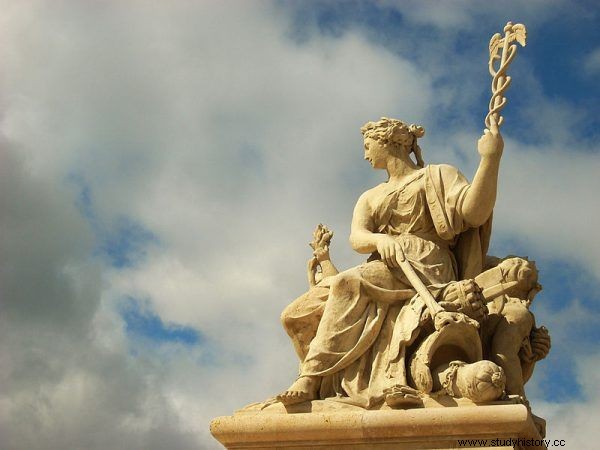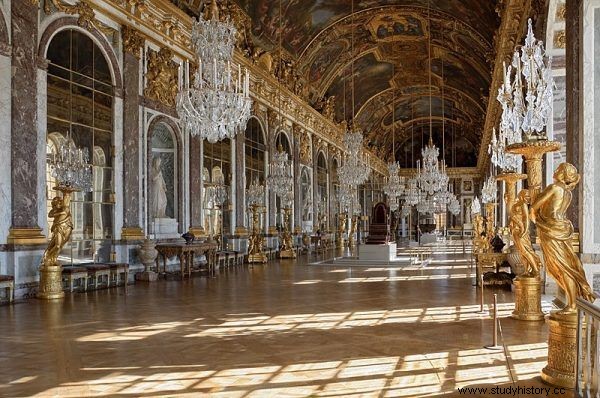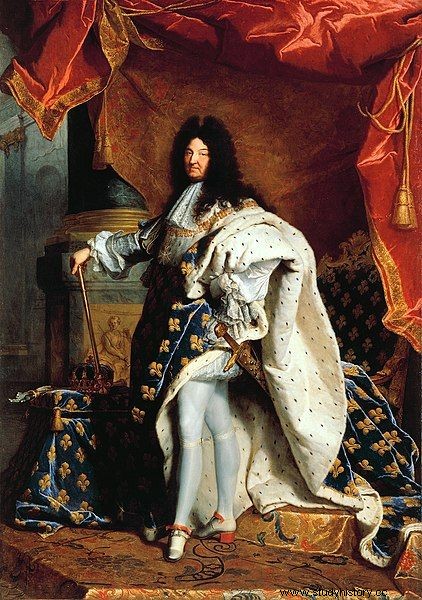The complex of palatial mansions in Versailles, the ancient seat of French rulers, is associated with us today in a rather unambiguous way. Glamor, beauty and wealth - a symbol of power and power. However, not all that glitters is gold. Because the historical truth about aristocratic life is quite… smelly.
Versailles is one of the showpieces of French culture. The town located about 40 kilometers from Paris is famous for its palace complex, which was built on the initiative of Louis XIV. We need to know that one of the most popular rulers of the Bourbon dynasty loved hunting from an early age - as a child he often went to his father's hunting palace in Versailles, located in former swamps, among forests and swamps.
A palace built on a real swamp
On the day of the death of Louis XIII the Righteous, the heir to the throne was only 4 springs, therefore he took the actual power in the state only at the age of 22 (previously his mother, Anna of Austria and the first minister, Jules Mazarin, ruled). Louis XIV's childhood dream of creating the most impressive palace in all of Europe was soon to come true. The choice of location was connected with sentiment, but also with the fact that there was already a hunting castle built by the father of the famous monarch.

Undoubtedly, the palace is still enchanting to this day.
The construction, begun in 1661, was attended by over 30,000 workers who laid the foundations for the imposing Palace of the Sun. According to conservative estimates, the costs associated with the construction, renovation and subsequent maintenance of the residence accounted for about 25% of the royal treasury. There are an impressive number of several hundred chambers in Versailles , and the so-called Solar Hall (also known as the Mirror Hall), the largest in the entire palace, filled with 17 huge mirrors that illuminate the room. On the other hand, frescoes were painted on the vault showing the military successes of Louis XIV. The effect is amazing. But also amazing were… the smells emanating from these elegant interiors.
Cramped, stuffy and smelly, or aristocratic discomfort
It is interesting that Versailles - the largest palace complex in the world - was crowded. It was experienced mainly by representatives of the service who used to settle in bunks, warehouses or in rooms intended for dressing rooms for the use of the state. It should also be taken into account that there were roughly a thousand people in the palace complex at the same time. It is a real breeding ground for natural bacteria that functioned in the former wetlands.

The Mirror Room in Versailles
Not all of them were forced to live in a crowded and stuffy life. Because, as is known, they are equal and more equal. The royal favorites could count on special treatment and luxurious apartments. In Versailles, one could find famous moles, including the Marquis of Montespan, the Marquis of Maintenon, the Duchess du Barry and the Marquis of Pompadour. The last, probably the most famous of the lovers of King Louis XV, was also the main organizer of the lavish balls at Versailles. And we must remember that the splendor of the palace coincided with the time of a certain Donatien Alphonse François de Sadea, the creator of the "120 days of Sodom, or the school of libertinism".
The court life was marked by betrayals and romances, political plots, moral conspiracies, and also - often - a frivolous atmosphere. It should also be remembered that the royal miseries often ruthlessly competed to expand their own erotic spheres of influence. And all in palace interiors, seemingly luxurious, but often stuffy, saturated with stench and dampness. The biological culture of germs was a big problem.
Sanitary problems, extreme needs and lack of toilets
It is not often mentioned that at Versailles, a symbol of luxury and comfort, there were basic necessities. A pressing problem was, among other things, the insufficient number of bathrooms that could be used not only by guests, but also by the servants. Of course, both the king and the queen had their own brass tubs, but the courtiers had to settle for fabrics soaked in vinegar water, which served to maintain the appearance of hygiene.

Louis XIV suffered from gastric problems
Although the reign of Louis XIV was marked by the development of art and fashion, caring for health was not a matter of course. An example was the ruler himself, who was not used to using cutlery at supper, and washed his hands most often with Bourbon which he estimated would ensure the elimination of undesirable bacteria. The shortcomings in the daily toilet were cleverly covered up - thanks to chewing clove flowers and other aromatic herbs that were supposed to eliminate the foul smell coming from aristocratic mouths.
However, the Versailles gardens often lacked water, so the fountains were never actually connected at the same time. Interestingly, a special instruction appeared on the premises of the palace complex, according to which only fountains should be open, near which the monarch and his entourage were passing. Savings your way, and representative functions its own. Besides, it was in the gardens that most often special balls were organized.
Culinary debauchery and corridors saturated with the smell of urine
Louis XIV loved to taste dishes, although, as we already know, he did not care much about hygiene. Unhealthy eating habits led to gastric revolutions. The repeated bloating, missed medical diagnoses, and finally the inconsistency of the king himself caused the Sun King to struggle with numerous gastric problems. The same goes for dozens of courtiers.

Versailles is visually stunning. It is worth remembering, however, that the realities of life in the palace were quite… smelly.
There was a lack of basic sanitary measures in Versailles. First of all, toilets. Embarrassing issues were dealt with in many different ways. Because for the courtiers, for example, there was an intimate place of retreat - curtains behind which you could use the potty or the toilet. Flushing toilets could not be seen. The conclusions are therefore self-evident - the royal staff took care of physiological needs wherever it was possible. Moreover, the royal dogs were also trained to pee where their rulers were. If we add alcoholic vapors to this scented bouquet, sweat that resulted from bed acrobatics, and seed… well. Here is the recipe for the royal stench.
Proof of apparent greatness
Versailles is part of the historical and cultural heritage of France. In many places - in corridors, vaults, cloisters - a symbol of the sun is visible, after all, Louis XIV himself went down in history as the Sun King. The construction of the palace was one of the evidence of the monarch's mania for grandeur. Because we also need to know that the royal property also includes a chapel, theater, stables, and apartments for officials and courtiers. However, the historical truth about aristocratic life is quite… stinky. The palace, built on a former swamp, for a long time functioned as a considerable habitat of bacteria, in which the smell of sweat, blood, sperm and perfume was mixed together to cover up the fragrant cocktail.
